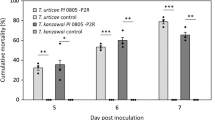Abstract
Photorhabdus luminescens is an entomopathogenic rod-shaped bacterium infected with insect nematodes of the Heterorhabditidae family. It kills insects through the secretion of high molecular weight toxin complexes. In this study, Plutella xylostella larvae were orally administered P. luminescens for bioassay. After incubation in Luria-Bertani (LB) medium for a sufficiently long period, the mortality rates of P. xylostella observed after diluting the fermentation broth 50 times and diluting the supernatant 5 times were 18.89% and 91.11%, respectively. Retentates measuring more than 70 kDa showed 88% mortality after ultrafiltration (UF) membrane treatment. Thus, the supernatant of P. luminescens had insecticidal activity, and the main insecticidal toxin complexes had a molecular weight exceeding 70 kDa. The L9 (34) Taguchi orthogonal experimental optimized medium mode-predicted insecticidal activity levels were 84% and 119% in the 50-fold diluted fermentation broth and 5-fold diluted supernatant, respectively. Moreover, the insecticidal activity was improved to 92.2% in the 100-fold diluted fermentation broth and to 97.8% in the 10-fold diluted supernatant in the experiments. All combinations tested showed clear indications of lethality, including swelling, vesicle formation, cytoplasm vacuolization, and brush border membrane lysis. Thus, these results promote the use of P. luminescens 0805-P2R as a potent biopesticide to effectively control P. xylostella.




Similar content being viewed by others
References
Ffrench-Constant, R. H., Dowling, A., & Waterfield, N. R. (2007). Insecticidal toxins from Photorhabdus bacteria and their potential use in agricultureToxicon, 49, 436–451.
Zalucki, M. P., Shabbir, A., Silva, R., Adamson, D., Shu-Sheng, L., & Furlong, M. J. (2012). Estimating the economic cost of one of the world’s major insect pests, Plutella xylostella (Lepidoptera: Plutellidae): just how long is a piece of string? Journal of Economic Entomology, 105(4), 1115–1129.
Furlong, M. J., Wright, D. J., & Dosdall, L. M. (2013). Diamondback moth ecology and management: problems, progress, and prospects. Annu Rev Entomol, 58, 517–541.
Sambrook, J., Frisch, E. F., & Maniatis, T. (1989). Molecular cloning: a laboratory manual (2nd ed.). Cold New York: Spring Harbor Laboratory, Cold Spring Harbor.
Denolf, P., Jansens, S., Van Houdt, S., Peferoen, M., Degheele, D., & Van Rie, J. (1993). Biotinylation of Bacillus thuringiensis insecticidal crystal proteins. Applied and Environmental Microbiology, 59(6), 1821–1827.
Tyagi, R. (2005). Cell biotechnology. New Delhi: Discovery Publishing Pvt. Ltd.
R Core Team, (2014) R foundation for statistical computing, Vienna. ISBN 3-900051-07-0.
Ben Hamadou, D., Boukedi, H., Abdelkefi-Mesrati, L., Tounsi, S., & Jaoua, S. (2013). Agrotis segetum midgut putative receptor of Bacillus thuringiensis vegetative insecticidal protein Vip3Aa16 differs from that of Cry1Ac toxin. Journal of Invertebrate Pathology, 114, 139–143.
Jallouli, W., Boukedi, H., Sellami, S., Frikha, F., Abdelkefi-Mesrati, L., Tounsi, S. (2018). Combinatorial effect of Photorhabdus luminescens TT01 and Bacillus thuringiensis Vip3Aa16 toxin against Agrotis segetum. Toxicon 142, 52–57.
Benfarhat-Touzri, D., Ben Amira, A., Ben Khedher, S., Givaudan, A., Jaoua, S., & Tounsi, S. (2013). Combinatorial effect of Bacillus thuringiensis kurstaki and Photorhabdus luminescens against Spodoptera littoralis (Lepidoptera: Noctuidae). Journal of Basic Microbiology, 54, 1160–1165.
Author information
Authors and Affiliations
Corresponding author
Ethics declarations
Conflict of Interest
The authors declare that they have no conflicts of interest.
Additional information
Publisher’s Note
Springer Nature remains neutral with regard to jurisdictional claims in published maps and institutional affiliations.
Rights and permissions
About this article
Cite this article
Wu, LH., Wang, YT., Hsieh, FC. et al. Insecticidal Activity of Photorhabdus luminescens 0805-P2R Against Plutella xylostella. Appl Biochem Biotechnol 191, 191–200 (2020). https://doi.org/10.1007/s12010-020-03289-8
Received:
Accepted:
Published:
Issue Date:
DOI: https://doi.org/10.1007/s12010-020-03289-8




